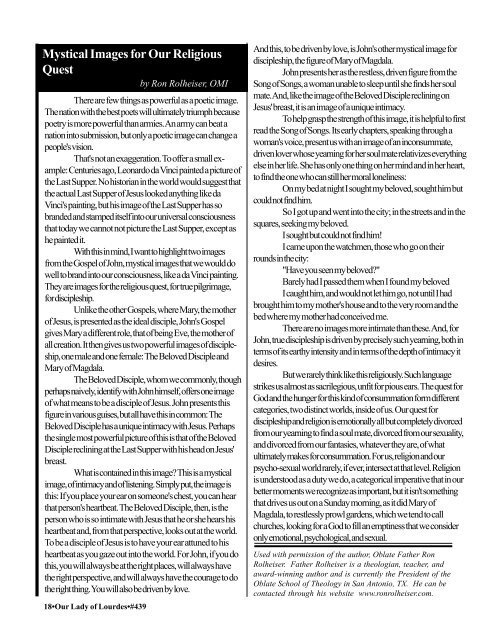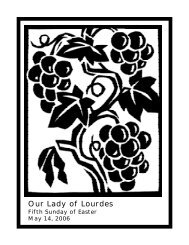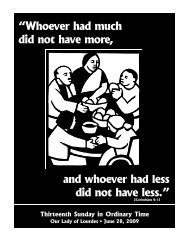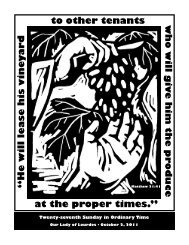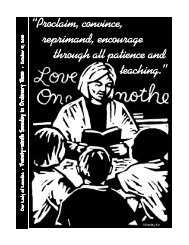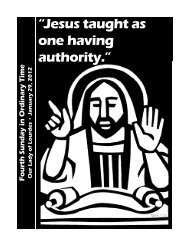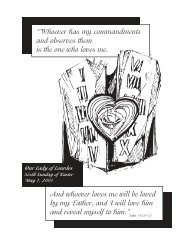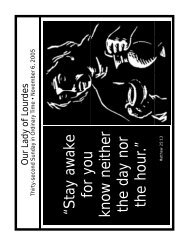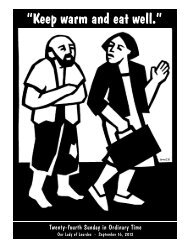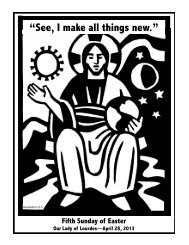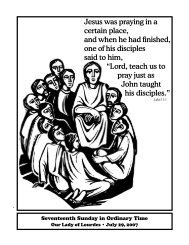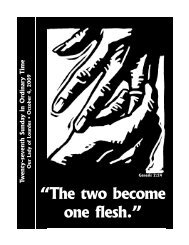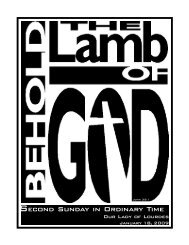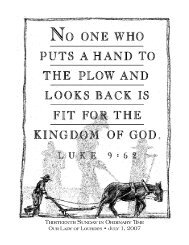May 23 - The Parish Family of Our Lady of Lourdes
May 23 - The Parish Family of Our Lady of Lourdes
May 23 - The Parish Family of Our Lady of Lourdes
Create successful ePaper yourself
Turn your PDF publications into a flip-book with our unique Google optimized e-Paper software.
Mystical Images for <strong>Our</strong> Religious<br />
Quest<br />
by Ron Rolheiser, OMI<br />
<strong>The</strong>re are few things as powerful as a poetic image.<br />
<strong>The</strong> nation with the best poets will ultimately triumph because<br />
poetry is more powerful than armies. An army can beat a<br />
nation into submission, but only a poetic image can change a<br />
people's vision.<br />
That's not an exaggeration. To <strong>of</strong>fer a small example:<br />
Centuries ago, Leonardo da Vinci painted a picture <strong>of</strong><br />
the Last Supper. No historian in the world would suggest that<br />
the actual Last Supper <strong>of</strong> Jesus looked anything like da<br />
Vinci's painting, but his image <strong>of</strong> the Last Supper has so<br />
branded and stamped itself into our universal consciousness<br />
that today we cannot not picture the Last Supper, except as<br />
he painted it.<br />
With this in mind, I want to highlight two images<br />
from the Gospel <strong>of</strong> John, mystical images that we would do<br />
well to brand into our consciousness, like a da Vinci painting.<br />
<strong>The</strong>y are images for the religious quest, for true pilgrimage,<br />
for discipleship.<br />
Unlike the other Gospels, where Mary, the mother<br />
<strong>of</strong> Jesus, is presented as the ideal disciple, John's Gospel<br />
gives Mary a different role, that <strong>of</strong> being Eve, the mother <strong>of</strong><br />
all creation. It then gives us two powerful images <strong>of</strong> discipleship,<br />
one male and one female: <strong>The</strong> Beloved Disciple and<br />
Mary <strong>of</strong> Magdala.<br />
<strong>The</strong> Beloved Disciple, whom we commonly, though<br />
perhaps naively, identify with John himself, <strong>of</strong>fers one image<br />
<strong>of</strong> what means to be a disciple <strong>of</strong> Jesus. John presents this<br />
figure in various guises, but all have this in common: <strong>The</strong><br />
Beloved Disciple has a unique intimacy with Jesus. Perhaps<br />
the single most powerful picture <strong>of</strong> this is that <strong>of</strong> the Beloved<br />
Disciple reclining at the Last Supper with his head on Jesus'<br />
breast.<br />
What is contained in this image? This is a mystical<br />
image, <strong>of</strong> intimacy and <strong>of</strong> listening. Simply put, the image is<br />
this: If you place your ear on someone's chest, you can hear<br />
that person's heartbeat. <strong>The</strong> Beloved Disciple, then, is the<br />
person who is so intimate with Jesus that he or she hears his<br />
heartbeat and, from that perspective, looks out at the world.<br />
To be a disciple <strong>of</strong> Jesus is to have your ear attuned to his<br />
heartbeat as you gaze out into the world. For John, if you do<br />
this, you will always be at the right places, will always have<br />
the right perspective, and will always have the courage to do<br />
the right thing. You will also be driven by love.<br />
18•<strong>Our</strong> <strong>Lady</strong> <strong>of</strong> <strong>Lourdes</strong>•#439<br />
And this, to be driven by love, is John's other mystical image for<br />
discipleship, the figure <strong>of</strong> Mary <strong>of</strong> Magdala.<br />
John presents her as the restless, driven figure from the<br />
Song <strong>of</strong> Songs, a woman unable to sleep until she finds her soul<br />
mate. And, like the image <strong>of</strong> the Beloved Disciple reclining on<br />
Jesus' breast, it is an image <strong>of</strong> a unique intimacy.<br />
To help grasp the strength <strong>of</strong> this image, it is helpful to first<br />
read the Song <strong>of</strong> Songs. Its early chapters, speaking through a<br />
woman's voice, present us with an image <strong>of</strong> an inconsummate,<br />
driven lover whose yearning for her soul mate relativizes everything<br />
else in her life. She has only one thing on her mind and in her heart,<br />
to find the one who can still her moral loneliness:<br />
On my bed at night I sought my beloved, sought him but<br />
could not find him.<br />
So I got up and went into the city; in the streets and in the<br />
squares, seeking my beloved.<br />
I sought but could not find him!<br />
I came upon the watchmen, those who go on their<br />
rounds in the city:<br />
"Have you seen my beloved?"<br />
Barely had I passed them when I found my beloved<br />
I caught him, and would not let him go, not until I had<br />
brought him to my mother's house and to the very room and the<br />
bed where my mother had conceived me.<br />
<strong>The</strong>re are no images more intimate than these. And, for<br />
John, true discipleship is driven by precisely such yearning, both in<br />
terms <strong>of</strong> its earthy intensity and in terms <strong>of</strong> the depth <strong>of</strong> intimacy it<br />
desires.<br />
But we rarely think like this religiously. Such language<br />
strikes us almost as sacrilegious, unfit for pious ears. <strong>The</strong> quest for<br />
God and the hunger for this kind <strong>of</strong> consummation form different<br />
categories, two distinct worlds, inside <strong>of</strong> us. <strong>Our</strong> quest for<br />
discipleship and religion is emotionally all but completely divorced<br />
from our yearning to find a soul mate, divorced from our sexuality,<br />
and divorced from our fantasies, whatever they are, <strong>of</strong> what<br />
ultimately makes for consummation. For us, religion and our<br />
psycho-sexual world rarely, if ever, intersect at that level. Religion<br />
is understood as a duty we do, a categorical imperative that in our<br />
better moments we recognize as important, but it isn't something<br />
that drives us out on a Sunday morning, as it did Mary <strong>of</strong><br />
Magdala, to restlessly prowl gardens, which we tend to call<br />
churches, looking for a God to fill an emptiness that we consider<br />
only emotional, psychological, and sexual.<br />
Used with permission <strong>of</strong> the author, Oblate Father Ron<br />
Rolheiser. Father Rolheiser is a theologian, teacher, and<br />
award-winning author and is currently the President <strong>of</strong> the<br />
Oblate School <strong>of</strong> <strong>The</strong>ology in San Antonio, TX. He can be<br />
contacted through his website www.ronrolheiser.com.


